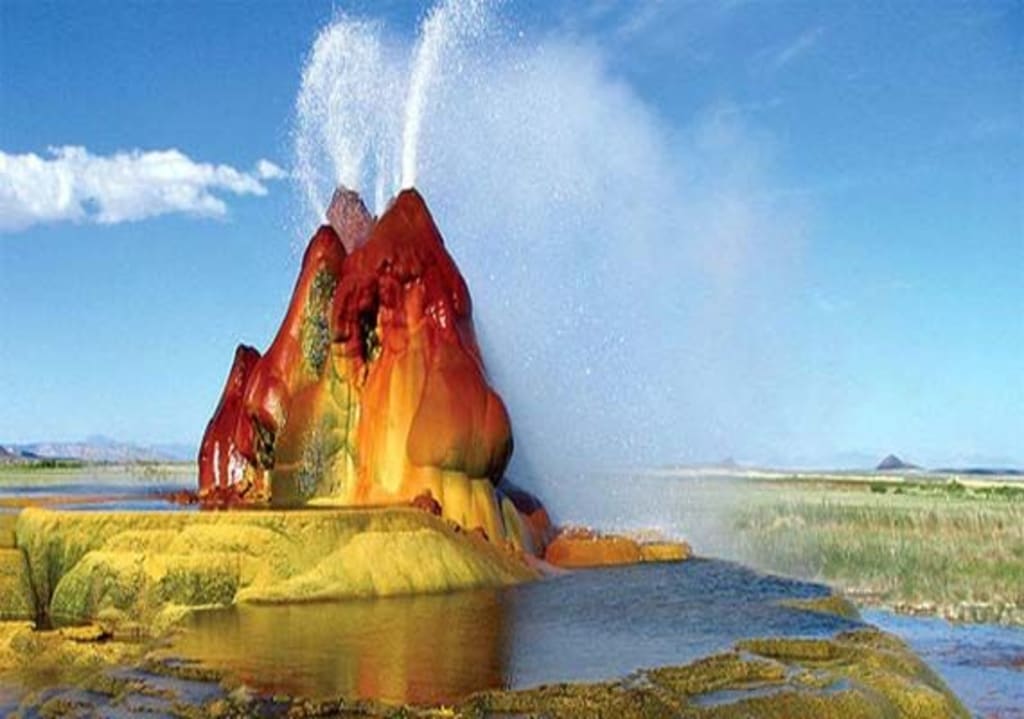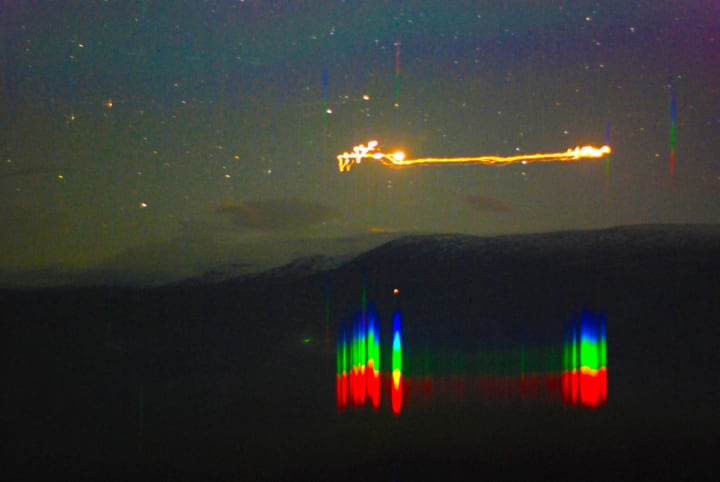5 places on the planet that science cannot explain
surprise for you

Our planet never ceases to amaze, because there are many places to strange beautiful and even frightening phenomena occur. people have been try to explain them for a long time: Magic, spirit or physics. Some secrets have been revealed, and some have yet to be thought about. In any case, these places deserve to be visited by the most daring and curious tourists. In this article we collected the top of 8 mysterious places on the planet that will surprise you.
1., Al-Nasla:

Al-Nasla is a sandstone formation located in the Tayma oasis in the Tabuk region of Saudi Arabia. The formation is notable for its unique split appearance, which has led some to speculate that it may be a work of ancient engineering or even evidence of extraterrestrial activity.
The split in the Al-Nasla formation is caused by natural geological processes. The sandstone rock is composed of layers of sedimentary rock that have been subjected to immense pressure over millions of years. This pressure has caused the rock to fracture along a fault line, resulting in the unique split appearance.
The split in the Al-Nasla formation is approximately 3 meters wide and 3 meters high. The two halves of the formation are nearly identical in size and shape, and they are separated by a narrow gap that runs down the center of the formation. The split is so clean and precise that it has led some to speculate that it may have been cut using advanced tools.
Despite these speculations, there is no evidence to suggest that the split in the Al-Nasla formation is the result of human engineering or extraterrestrial activity. Instead, it is a natural geological formation that is the result of millions of years of natural processes.
The Al-Nasla formation is a popular tourist destination in Saudi Arabia, and it is frequently visited by tourists and photographers who are drawn to its unique appearance. The formation is located in a remote area, and visitors must travel a long distance over rough terrain to reach it. However, many people consider the journey to be worth it, as the Al-Nasla formation is considered to be one of the most unique and beautiful natural formations in the world.
2., Darvaza:

Darvaza, also known as the "Door to Hell," is a natural gas crater located in the Karakum Desert in Turkmenistan. The crater is known for its fiery appearance and has become a popular tourist destination in recent years.
The Darvaza crater was created in 1971, when Soviet geologists were drilling for natural gas in the area. During the drilling process, they accidentally hit a pocket of natural gas, causing the ground to collapse and creating the large crater. The gas that was released into the crater was found to contain toxic fumes, so the geologists set the gas on fire in an attempt to burn off the fumes.
The fire has been burning continuously ever since and is now a permanent feature of the landscape. The flames can reach up to 3-4 meters in height, and the heat from the fire can be felt from several meters away. The crater is approximately 69 meters wide and 30 meters deep.
The name "Door to Hell" was given to the crater by local residents, who were frightened by the fiery appearance of the crater and the sounds that it made. Despite its intimidating appearance, the Darvaza crater has become a popular tourist attraction in recent years, with visitors from around the world coming to see the fiery spectacle.
While the Darvaza crater is a fascinating natural phenomenon, it is also a reminder of the dangers of natural resource extraction. The release of toxic fumes during the drilling process highlights the importance of responsible resource management and the need to protect the environment. Despite its dangers, the Darvaza crater remains an intriguing and awe-inspiring natural wonder that continues to draw visitors from around the world.
3., Lights of Hessdalen:

The Lights of Hessdalen are an unexplained and mysterious phenomenon that occurs in the sky above the Hessdalen Valley in Norway. The lights have been observed since the 1940s and have attracted the attention of scientists, UFO researchers, and conspiracy theorists alike.
The Lights of Hessdalen are typically described as bright, white or yellow lights that appear to be floating in the sky. The lights can move slowly or quickly and can change direction and shape. Some witnesses have reported seeing the lights form into triangular or diamond-shaped formations, while others have seen them pulsate or flicker.
The lights have been observed over the Hessdalen Valley for many years, and many theories have been put forward to explain their origin. Some scientists believe that the lights are caused by a natural phenomenon, such as atmospheric plasma or electrical charges in the air. Others believe that the lights may be the result of man-made objects, such as drones or experimental aircraft.
Despite numerous studies and investigations, no definitive explanation for the Lights of Hessdalen has been found. Some researchers have suggested that the phenomenon may be related to the mineral deposits in the area, which could be creating electrical charges in the air. Others have suggested that the lights may be the result of some kind of advanced technology, possibly from extraterrestrial sources.
The Lights of Hessdalen have attracted the attention of many scientists and researchers over the years, and several studies have been conducted in an attempt to understand the phenomenon. In recent years, a team of researchers from the Italian National Research Council has been studying the lights using high-tech equipment, such as spectrometers and magnetometers, in an effort to gain a better understanding of their origin.
While the Lights of Hessdalen remain a mystery, they continue to fascinate and intrigue people from all over the world. The phenomenon has become a popular tourist attraction, and visitors from around the world come to the Hessdalen Valley in the hopes of catching a glimpse of the mysterious lights.
4., Russian Stonehenge:

The Russian Stonehenge is a set of megalithic structures located in the Ural Mountains of Russia. The structures, which were discovered in the 1990s, are believed to be more than 4,000 years old and are similar in style to the megaliths found at Stonehenge in England.
The Russian Stonehenge consists of several large stone circles, each containing several standing stones. The circles range in size from 8 to 30 meters in diameter, and the standing stones can be up to 4 meters tall. The stones are made of a type of local sandstone and are decorated with intricate carvings of geometric shapes, human figures, and animals.
The purpose of the Russian Stonehenge is not fully understood, but it is believed to have been a ceremonial site used for religious or spiritual purposes. Some researchers have suggested that the site may have been used for astronomical observations or as a calendar, as the stones are aligned with the sun and other celestial bodies.
The Russian Stonehenge is one of the largest and most well-preserved megalithic structures in Russia, and it has attracted the attention of archaeologists and researchers from around the world. The site is also a popular tourist attraction, and visitors can explore the stone circles and see the intricate carvings up close.
Despite its significance, the Russian Stonehenge is not widely known outside of Russia, and many people are still unaware of its existence. The site is located in a remote area of the Ural Mountains, and access is limited, which has helped to preserve the site from vandalism and other forms of damage.
In recent years, efforts have been made to promote the Russian Stonehenge as a cultural and historical landmark, and there have been calls to have the site recognized as a UNESCO World Heritage Site. With continued research and conservation efforts, the Russian Stonehenge may one day be recognized as one of the world's most important and significant megalithic sites.
5., Stone balls of cost Rica:

The Stone Balls of Costa Rica, also known as the Diquís Spheres, are a collection of over 300 stone balls located in the Diquís Delta region of Costa Rica. The spheres range in size from a few centimeters to over 2 meters in diameter and are made of a type of granite rock that is not native to the area.
The exact purpose and origin of the Stone Balls of Costa Rica are not fully understood. The spheres were first discovered in the 1930s when banana plantations were being established in the region, and since then, many theories have been put forward to explain their origin and significance.
Some researchers believe that the spheres were created by the indigenous people who lived in the area over 1,000 years ago. They may have been used for religious or ceremonial purposes or as symbols of power or wealth. Others believe that the spheres may have been created as part of a game or sport, as some of the smaller spheres have been found with carved grooves or markings that suggest they may have been used as balls or rollers.
The Stone Balls of Costa Rica are also notable for their remarkable craftsmanship. The spheres are nearly perfectly round and are believed to have been carved using primitive tools, such as hammers and chisels. The surface of the spheres is smooth and polished, with no visible tool marks or flaws.
The Stone Balls of Costa Rica have become a popular tourist attraction, and many of the spheres are now protected by the Costa Rican government. Efforts have been made to preserve and study the spheres, and several have been transported to museums around the world for further analysis.
Despite decades of research, the exact purpose and origin of the Stone Balls of Costa Rica remain a mystery. The spheres continue to fascinate and intrigue people from around the world, and they are considered to be one of the most significant archaeological finds in Central America.






Comments
There are no comments for this story
Be the first to respond and start the conversation.